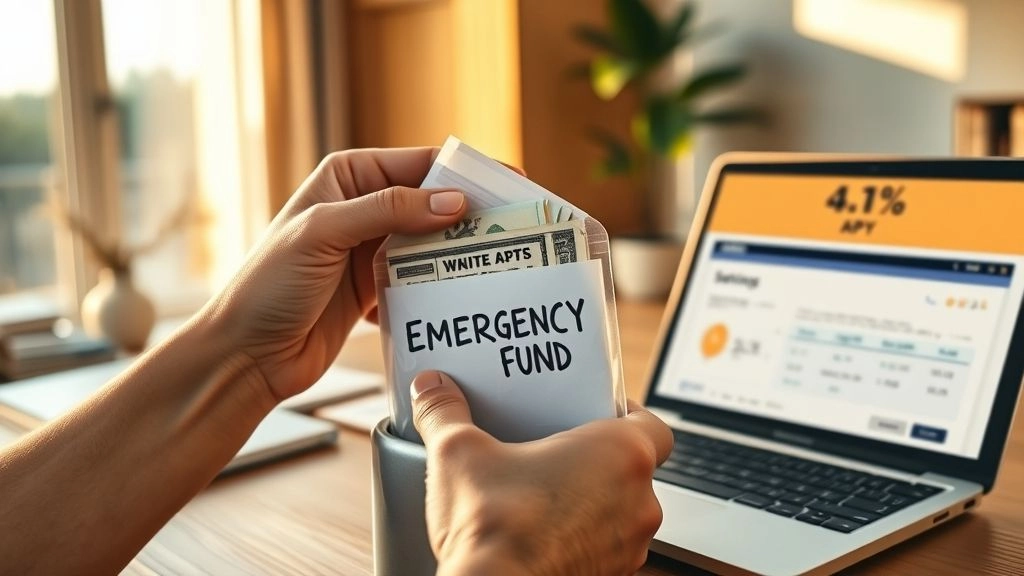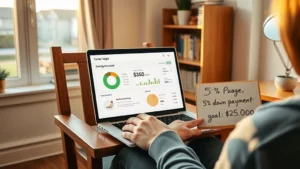Picture This: Real-Life Oops
Let’s be honest… have you ever “forgotten” about the money sitting quietly in your checking account, then—poof!—one random week, it’s just gone? Maybe it slipped away on late-night takeout, a surprise birthday gift, or, my personal favorite, those sneaky “little” Amazon orders. I used to do this all the time. I’d tell myself, “Oh, I’ll just keep my safety cushion in checking—easy access, right?” Until my car broke down and, oops… my “emergency” cash had mysteriously vanished. All that was left? Guilt and overdraft fees.
Can you relate? Regular checking accounts are like the living room of your finances—busy, noisy, and everything gets lost in the couch cushions. That’s why today, I want to talk about a simple question that packs a seriously frugal punch: why shouldn’t you keep your emergency fund money in your checking account?
Emergency Fund’s Secret Purpose
It’s for Surprises, Not Splurges
So, what’s the real deal with emergency funds? It’s not just “extra savings.” It’s your superhero cape when life throws a punch—think sudden medical bills, a totaled car, or your old fridge choosing the hottest week of summer to die.
Unlike a savings account for vacation dreams or a fancy new laptop, the emergency fund is for real, unplanned shocks. Not for “I forgot my bestie’s birthday and need cupcakes now.” how is an emergency fund similar to and different from a savings fund? lays it out: one is for curveballs, the other for goals you see coming from miles away.
Mini Table: Compare at a Glance
| Aspect | Emergency Fund | Regular Savings |
|---|---|---|
| Purpose | Unexpected stuff (ugh!) | Planned stuff (yay!) |
| Access Speed | Fast, but separate | Flexible, might wait longer |
| Best Place | High-yield savings | Anywhere it grows |
The Temptation Trap
Why Does Checking Feel “Safe” Anyway?
I totally get the thinking—checking is right there, one tap away. “Easy access in case of emergency,” we tell ourselves. But here’s the thing… checking accounts are financial black holes. They swallow anything that comes near.
Need an example? True story: last Christmas, I left an extra $1,000 in checking as my “stormy weather” stash. By January, it was… gone. I’d bought an extra turkey, some small kitchen gadgets, and paid for a spontaneous weekend road trip. When my dentist (why do teeth always attack at the worst moment?) handed me a surprise bill, I had $32 left. Ouch.
How Easy Is It to Slip?
Checking accounts aren’t just convenient. They’re downright tempting. They come with debit cards. Bill pays. Venmo. Groceries. Overdraft “protection.” No roadblocks. Every impulse—”Should I DoorDash tacos tonight?”—gets a green light. By the time a real emergency hits, that so-called “emergency fund” is already gone, one small swipe at a time.
Research on spending habits even shows that folks with “cash stashes” in their regular checking spend more on non-essential stuff… and almost never realize it. You can read about this in some financial experts’ advice.
Pros vs. Cons in Real Life
Checking Pros: You get instant access… but at what cost? That little cushion is always at risk.
Checking Cons: No growth, more temptation, zero separation from bills and splurges.
Let Your Money Work (Not Sit)
Seriously—Checking Pays You…Nothing
Let’s talk numbers. Most checking accounts cough up interest rates so tiny—think 0.01%. That’s literally pennies a year, even if you’re stockpiling thousands. Meanwhile, inflation quietly makes your hard-earned cash weaker by the month. If your emergency fund sits in checking, you might as well be stuffing it under your mattress. Sad, but true.
Meanwhile, high-yield savings accounts? Those little hidden gems pay 4–5% these days! Your emergency fund isn’t just protected—it’s growing, doing a quiet little side hustle for you.
Picture this: You’re working toward a $30,000 emergency fund. In checking, you’re missing out on $1,000+ in interest every single year. That’s a lot of groceries, folks. Or, honestly, some well-needed self-care when things get rough.
But What If I Need Money Fast?
Great question. The trick is “accessible, but a little inconvenient.” High-yield savings (or a money market account, if you’re fancy) let you instantly move money in an emergency. But putting even a one-day delay between you and unnecessary spending? Total game-changer. When I moved my emergency fund to a totally separate savings account (with a different login!), I found it way easier to ignore it. Out of sight, out of mind.
Practical Moves for Frugal Folks
How Much Should You Really Save?
Let’s be real: “Three to six months’ expenses” sounds like something only billionaires pull off. Don’t let that stress you out. Start with $500 or $1,000. If you’re paid every two weeks, skimming off even $20–$50 each paycheck builds up surprisingly quick.
Got a gig income, or uncertain work? That’s where a chunky emergency fund really pays off. Wondering your magic number? I love the Emergency fund calculator. Plug in your rent, bills, food, gas—not a number out of thin air, but real, practical needs.
Want some inspiration? Scroll through Emergency fund examples for stories you’ll relate to—families, singles, folks grinding side hustles. My favorite? The single mom who set up auto-transfers for $25 a week, and two years later checked her balance: $3,000. She hadn’t even missed it.
Where Should You Park That Cash?
Friends don’t let friends leave emergency funds in checking. High-yield savings is the classic move—FDIC-insured, easy transfers, but not too easy. Some folks like credit union market accounts for slightly higher rates. The key is to keep it separate… and maybe make it just a little bit annoying to spend. No temptation = peace of mind.
But avoid turning your fund into an “investment” project. Don’t stick it in stocks or bonds. In a crisis, your “emergency” could turn into a “huge loss” overnight. And please, don’t stash it in cash under your bed. Ever had a dog chew up $100 bills? I have. Don’t ask.
Small Steps, Big Wins
Automate—and Forget!
Want the lowest-effort way to build an emergency cushion? Automate your transfers. Set a date right after payday, so you never even see that money. I started with $10/week and upped it little by little. I barely felt it… except when life hit, and that fund was there like a loyal old friend.
Don’t make saving a battle of willpower. Take yourself out of the equation. If you want to take it a notch further, open your high-yield savings at an entirely different bank than where you do checking. The hurdle to spend will feel magically higher.
Real Talk: Don’t Chase Perfection
Life is messy, and building a safety net doesn’t happen overnight. There will be setbacks—maybe you dip into your fund for something that wasn’t quite an emergency. That’s okay. The frugal path isn’t about perfect discipline. It’s about trying, learning, and course-correcting.
Shooting for a $30,000 emergency fund? Celebrate every milestone. Hit $500? That could be the tow truck bill covered, not a new reason for credit card debt. Made it to $5,000? Maybe that lets you face a job layoff or surprise dental bill without panic. Small wins add up. You’re building resilience, one boring old transfer at a time.
One Last Thing—Let’s Reflect
Take a look at your bank account right now. Do you know the difference between your “emergency” dollars and your “spending” dollars? Or is it all just one big swimming pool, where money floats away on summer days and stressy nights?
I finally learned to keep my safety net out of reach. Now, surprise bills are just an inconvenience, not a crisis. Every time I check my boredom-inducing, separate savings account, I kind of want to give it a high-five. It’s my hard-earned “sleep soundly” fund… and nothing (not pizza cravings, not concert tickets, not sudden shoe sales) is going to sneak it away again.
Wrapping It All Up (Promise, No Lecture)
You get to decide: are you cool with every paycheck washing in and out of checking, making your “emergency fund” a mirage? Or do you want real, grownup peace of mind—without worrying your fridge or car will make you broke overnight? why shouldn’t you keep your emergency fund money in your checking account? So you don’t lose it to life’s distractions.
Keep your emergency fund in its own, high-yield, slightly-dull savings account. Build it up with tiny, automatic transfers. Use Emergency fund calculator for real-life targets. Get inspired by Emergency fund examples—big, small, or even that audacious $30,000 emergency fund.
Small moves, big difference. That’s the frugal life. Ready to start? Tell me: How are you going to separate your fund once and for all? Hit reply, or just make that first transfer. Your future self will totally thank you… and so will your sleep.













